Not critically rated, but could North Melbourne defy the sceptics and climb the ladder with some help from a favourable draw? Photo: GETTY IMAGES
AFL fixture: Footyology formula names winners and losers
If you think the AFL fixture plays a critical part in helping clubs climb up the ladder, you’d be looking even closer than usual at the 2018 schedule, released on Tuesday, given the events of the season just concluded.
I’ve been conducting a detailed analysis of the fixture now for the past eight years, and in 2017 more than perhaps any other, a favourable draw (in football terms) certainly helped.
Last year, I rated Essendon, Port Adelaide and Richmond, none of whom had made finals in 2016, as having the three best draws in the competition. The Bombers and Power both got to September, and the Tigers? Well, we all know how that finished.
Richmond this year met just one 2016 finalist twice and travelled to Perth only once. Given it had reached finals three years in a row prior to 2016 and had recruited solidly in the trade period, its draw was certainly encouraging.
So who’s best-placed to “do a Richmond” in 2018 off the back of some fixturing largesse from the AFL?
Well, Collingwood has done pretty well, by my calculations the Magpies with the third-best draw for next season. If the Western Bulldogs’ failure to back up their 2016 flag with even a finals spot this year proves an aberration, a draw for next season by my reckoning the fifth-best in the AFL will prove handy.
But if you want a real bolter for next year based on the widespread forecasts of doom and gloom about its future, check out the hand North Melbourne has been dealt by the fixturers before you scoff too much about the Roos’ 2018 prospects.
It seems many have already consigned North to the bottom couple of spots on their 2018 ladders based on their failure to land a “big fish” and a major list overhaul over the past couple of years. But I’m far from convinced that will be the case, and perhaps even less so now after this fixture.
By my measure, the Roos have by some margin the best draw for 2018, playing just one top eight team (Sydney) but both the bottom two (Brisbane and Gold Coast) from this year twice.
They make only five road trips (not including their home games in Hobart, where they have now won 11 of 15 games), only one of which is in Perth. And the Roos also have a real chance to get off to a good start, with their first clash with a 2017 finalist not coming until round six.
Not bad for a side which while it only won six games, lost another five by a combined total of just 14 points, effectively three goals away from an 11-win season.
Collingwood, too, might be one to watch, given a much more solid finish than start to 2017, no more Nathan Buckley speculation, and now a draw which has return clashes with only two finalists, only five road trips (just one in Perth) and 14 games on the MCG, including five of the first six.
Footyology’s assessment of the winners and losers out of the AFL fixture takes into account far more than merely the five teams each club meets twice in their 22 games.
That’s only one of four key factors – the others road trips, the home-versus-interstate-side advantage, and the very significant consecutive six-day breaks, the latter consideration one of the biggest red flags for club football departments when they get their hands on next season’s schedule.
Justifiable anxiety, too, when you look at last season. Melbourne was the only club in 2017 to have to negotiate three six-day breaks in a row. It scored its best win of the season against West Coast in Perth in the second of those, but barely fired a shot against Sydney the following week.
Two more clubs, Hawthorn and St Kilda, were dealt two lots of successive six-day breaks. The Hawks were smashed in both final legs of their assignments, and the Saints similarly were hammered by 10 goals against Essendon six days after their best win over Richmond.
On that score, there will be plenty of relief at this fixture, the AFL doing very well to reduce the 15 instances of consecutive six-day breaks in 2017 down to just seven year, and no cub having to attempt what the Demons did.
Fremantle makes history on the “home versus interstate club” front, too, with no fewer than 11 games at the new Perth Stadium against an interstate opponent, courtesy of Gold Coast having to sell a home game to the Dockers in round three because of the Commonwealth Games.
If you throw in more “home” games in Shanghai, Cairns and the Gabba, the Suns will be doing no fewer than 15 road trips next season, the minor upside that they at least finish with seven out of 11 at Metricon Stadium.
I reckon Hawthorn is another club which has done particularly well in a football as well as commercial sense with this fixture, certainly relatively speaking.
This is the first time in six years that, going by my formula, the Hawks haven’t had either the toughest or second-toughest draw in the competition. In 2018, they’ve got the seventh-best, not so much because of whom they play twice, but based on the road trip and home state advantage factor.
Leaving out their Aurora Stadium second home, the Hawks make just four road trips (two of them short hauls to Sydney). Including Launceston (where they’ve now won 43 of 56 home games) they have seven games against an opponent from interstate.
Remember, too, this is a team which won or drew seven of its last 10 games this year and regains long-term casualties and senior hands in Cyril Rioli, Grant Birchall, Ben Stratton and James Frawley.
Not surprisingly, Richmond and Adelaide have been dealt two of the tougher hands. But supposed up-and-comers St Kilda and Melbourne haven’t been cut a lot of slack for failing to make finals this year, the Saints and Demons on these numbers with the fourth and fifth-hardest fixtures.
And spare a thought for West Coast, undergoing some pretty dramatic generational change, having to find the nucleus of a new-look midfield group, and now dealt, in Footyology’s view, officially the toughest fixture of the lot.
While they’ll have seven of their first 11 games at Perth Stadium (and it could take the Eagles a while to familiarise themselves with a new ground as much as visitors), they have not only the usual swag of long-haul trips out of Perth, but return clashes against three top eight teams, last year’s premiers and the always-unpredictable local rival. It’s a fair ask.
A favourable draw isn’t necessarily the be-all and end-all. You’ve still got to beat the best at some stage, and if your club appears to have been dealt a tough hand, consider this long-term evidence.
Over the past four seasons, only eight teams from a total of 32 boasting what I ranked among the best eight draws in the AFL were able to use the leg-up as a catapult towards finals football. It’s hardly a compelling strike rate, reasonable evidence that talent generally prevails.
Then again, in a competition as tight as the AFL is nowadays, every little bit helps. And just as a few more goals might well have placed North Melbourne on the fringes of the eight instead of 15th this year, perhaps a few more winnable games in 2018 might do the trick.

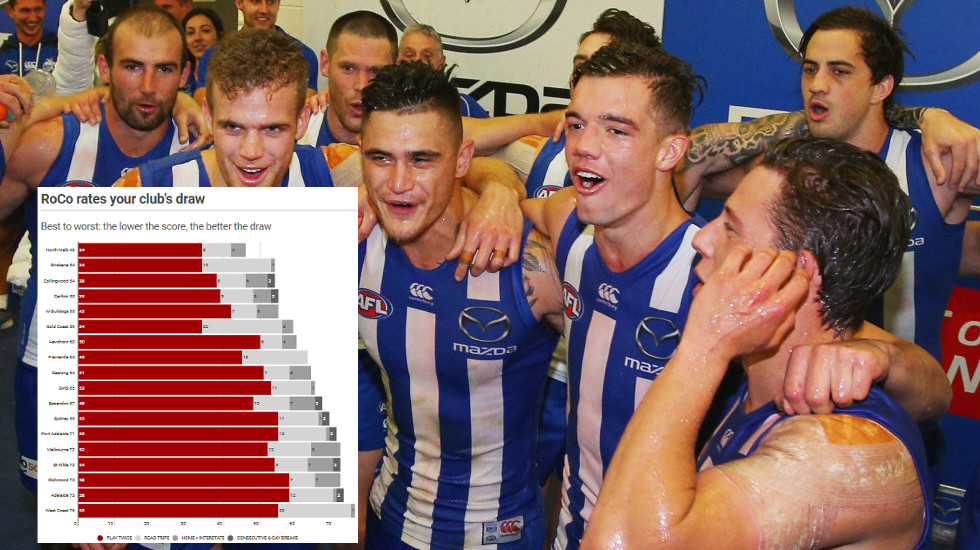
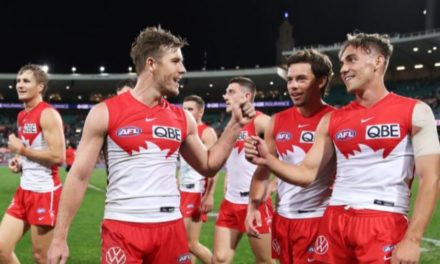
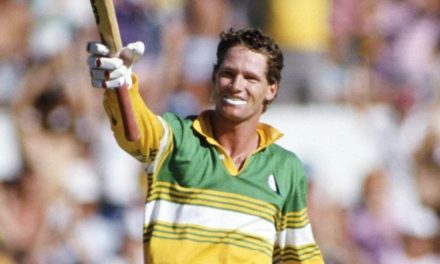

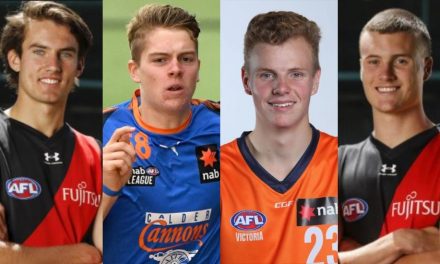
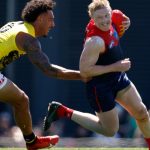





Rohan.
A comment on your team ranking – you basically give each team a positional rank (RIC 18, ADE 17, etc). Have you considered using no of wins instead? This could weight the teams more fairly when there are bigger steps on the ladder under the wins column.
For example ‘A’ could be 12th with 8 wins, and ‘B’ could be 13th with 5 wins. Those 3 wins are a better definer of the teams than the single increment of ladder position.
Thoughts?
@Joe
Yep- works a treat
https://footymaths.blogspot.com.au/p/we-have-posted-before-on-this-blog.html
(apologies Rohan for linking – delete if you wish)
Still think the AFL needs to go to a conference format of 3 divisions of 6 teams. Play each team in your division twice = 10 games then other divisions once = 12 games. Top 2 in each division make finals then the next two with the best records get the last two finals spots. It means you have the same fixture as the teams you are competing with for finals spots and can help avoid dead games towards the end of the season.
Carlton for finishing 16th are rewarded with 5th Friday nights when really they should’ve given off broadway slot such as Saturday 2:10pm Saturday twilight sunday 1:10pm or sunday Twlight as for the AFL now labelling Richmond v carlton as the traditional season opener come On AFL Round 1 Game 1 Should be the GF Replay I Would Play 2 Sunday Matches During The season Richmond V Carlton Easter Sunday Night @ the MCG 1st Bounce 6:50pm Essendon V North Melbourne June Long Weekend Sunday @ Etihad Stadium 1st Bounce 6:50pm
Fantastic analysis Rohan.
Given that 2 of Hawthorn 2-time opponents will be coming off successive 6 days breaks (Sydney in round 23 & Essendon in round 7, who’ll actually be playing 3 games in 11 days), their fixture is probably even better than 7th…